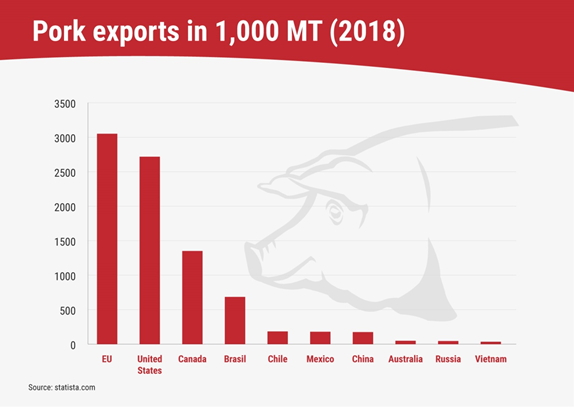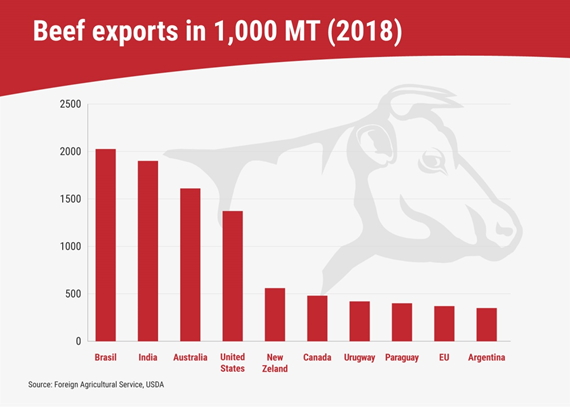The European Union is at the forefront of countries producing pork and beef. This meat, known for its quality and taste, finds recipients all over the world. In 2018, the EU maintained its leadership status in pork export and a high position in the export of beef to non-EU countries.
Pork production in the EU has been stable for several years. In 2018, the European Union countries produced a total of 23.7 million tons of pork. It places the European Union second in the world following China (55.4 million tons) and before the United States (11.6 million tons).[1] Pork exports to third countries were slightly higher than a year earlier: 3.87 million tons compared to 3.84 million tons in 2017. In the first four months of 2019, export increased by as much as 13.2% compared to the same period a year earlier[2].
The export of dried and smoked pork is growing dynamically. In 2018, its value increased compared to the previous year by 7.6%, and the volume – by as much as 9%. The main recipients of this type of products are the United States (increase in export volume by as much as 15.7%), Japan, Australia, Switzerland, Serbia, and Canada (increase in export volume by 3%).[3]
Pork sausages are very popular among international buyers. While the volume of export remains stable, the value of goods sold is increasing – this means that importers are willing to pay more for sausages from the European Union. [4]
The European Union remains the world’s largest exporter of pork products, ahead of the United States and Canada on this list[5].

In 2018, beef production in the European Union countries increased by 1.6% to 7.92 million tons.[6] It accounts for about 12% of all world production of this kind of meat.
The European Union is a significant global exporter of beef. More is sold by countries such as: The United States, Brazil, Australia, India, New Zealand, Canada, Uruguay, and Argentina. Fresh and frozen meat are mostly exported, followed by beef products. Last year there was a dynamic 23% increase in exports from the European Union of fresh and chilled beef (up to 131.5 thousand tons), while the sales of frozen meat decreased slightly (up to 88.4 thousand tons). [7]

- [1] https://ec.europa.eu/agriculture/sites/agriculture/files/market-observatory/meat/pigmeat/doc/dashboard-pig_en.pdf
- [2] https://ec.europa.eu/agriculture/sites/agriculture/files/market-observatory/meat/pigmeat/doc/dashboard-pig_en.pdf
- [3]Civil Dialogue Group on Pigmeat Report, 29 May 2019
- [4]Civil Dialogue Group on Pigmeat Report, 29 May 2019
- [5]Civil Dialogue Group on Pigmeat Report, 29 May 2019
- [6] https://ec.europa.eu/agriculture/sites/agriculture/files/market-observatory/meat/beef/doc/beef-production_en.pdf
- [7] https://madb.europa.eu/madb/statistical_form.htm
